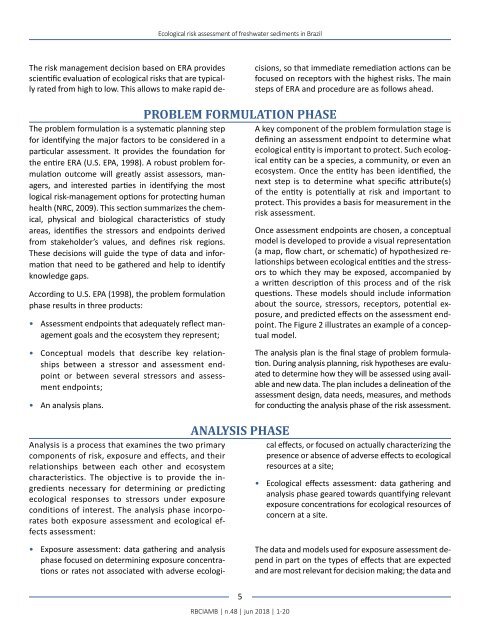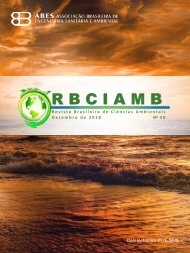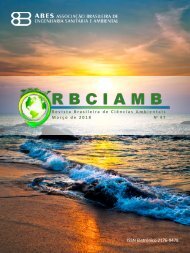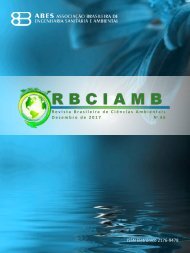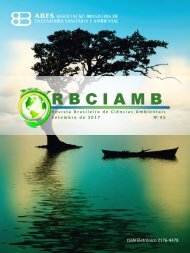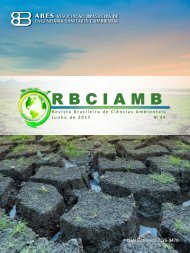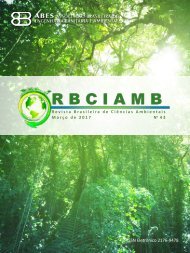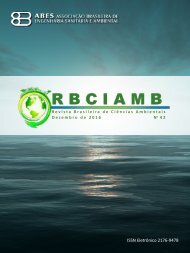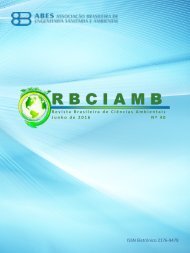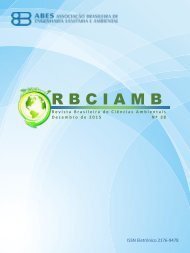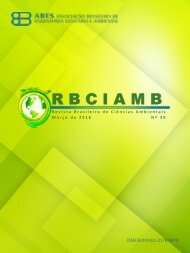Edição 48 RBCIAMB
You also want an ePaper? Increase the reach of your titles
YUMPU automatically turns print PDFs into web optimized ePapers that Google loves.
Ecological risk assessment of freshwater sediments in Brazil<br />
The risk management decision based on ERA provides<br />
scientific evaluation of ecological risks that are typically<br />
rated from high to low. This allows to make rapid decisions,<br />
so that immediate remediation actions can be<br />
focused on receptors with the highest risks. The main<br />
steps of ERA and procedure are as follows ahead.<br />
The problem formulation is a systematic planning step<br />
for identifying the major factors to be considered in a<br />
particular assessment. It provides the foundation for<br />
the entire ERA (U.S. EPA, 1998). A robust problem formulation<br />
outcome will greatly assist assessors, managers,<br />
and interested parties in identifying the most<br />
logical risk-management options for protecting human<br />
health (NRC, 2009). This section summarizes the chemical,<br />
physical and biological characteristics of study<br />
areas, identifies the stressors and endpoints derived<br />
from stakeholder’s values, and defines risk regions.<br />
These decisions will guide the type of data and information<br />
that need to be gathered and help to identify<br />
knowledge gaps.<br />
According to U.S. EPA (1998), the problem formulation<br />
phase results in three products:<br />
• Assessment endpoints that adequately reflect management<br />
goals and the ecosystem they represent;<br />
PROBLEM FORMULATION PHASE<br />
A key component of the problem formulation stage is<br />
defining an assessment endpoint to determine what<br />
ecological entity is important to protect. Such ecological<br />
entity can be a species, a community, or even an<br />
ecosystem. Once the entity has been identified, the<br />
next step is to determine what specific attribute(s)<br />
of the entity is potentially at risk and important to<br />
protect. This provides a basis for measurement in the<br />
risk assessment.<br />
Once assessment endpoints are chosen, a conceptual<br />
model is developed to provide a visual representation<br />
(a map, flow chart, or schematic) of hypothesized relationships<br />
between ecological entities and the stressors<br />
to which they may be exposed, accompanied by<br />
a written description of this process and of the risk<br />
questions. These models should include information<br />
about the source, stressors, receptors, potential exposure,<br />
and predicted effects on the assessment endpoint.<br />
The Figure 2 illustrates an example of a conceptual<br />
model.<br />
• Conceptual models that describe key relationships<br />
between a stressor and assessment endpoint<br />
or between several stressors and assessment<br />
endpoints;<br />
• An analysis plans.<br />
The analysis plan is the final stage of problem formulation.<br />
During analysis planning, risk hypotheses are evaluated<br />
to determine how they will be assessed using available<br />
and new data. The plan includes a delineation of the<br />
assessment design, data needs, measures, and methods<br />
for conducting the analysis phase of the risk assessment.<br />
Analysis is a process that examines the two primary<br />
components of risk, exposure and effects, and their<br />
relationships between each other and ecosystem<br />
characteristics. The objective is to provide the ingredients<br />
necessary for determining or predicting<br />
ecological responses to stressors under exposure<br />
conditions of interest. The analysis phase incorporates<br />
both exposure assessment and ecological effects<br />
assessment:<br />
ANALYSIS PHASE<br />
• Exposure assessment: data gathering and analysis<br />
phase focused on determining exposure concentrations<br />
or rates not associated with adverse ecological<br />
effects, or focused on actually characterizing the<br />
presence or absence of adverse effects to ecological<br />
resources at a site;<br />
• Ecological effects assessment: data gathering and<br />
analysis phase geared towards quantifying relevant<br />
exposure concentrations for ecological resources of<br />
concern at a site.<br />
The data and models used for exposure assessment depend<br />
in part on the types of effects that are expected<br />
and are most relevant for decision making; the data and<br />
5<br />
<strong>RBCIAMB</strong> | n.<strong>48</strong> | jun 2018 | 1-20


